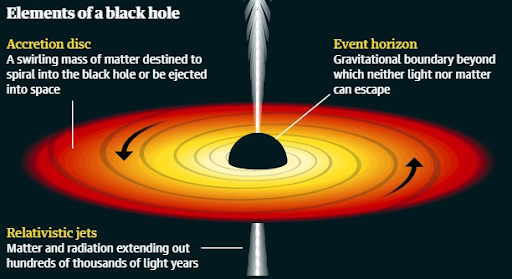Science & Technology
Merger of Three Supermassive Black Holes
- 28 Aug 2021
- 5 min read
Why in News
Recently, the Department of Science and Technology reported that Indian scientists have discovered the merger of three supermassive black holes from as many galaxies to form a triple Active Galactic Nucleus.
- Many Active Galactic Nuclei (AGN) pairs have been detected in the past, but triple AGN are extremely rare, and only a handful has been detected before using X-ray observations.
Key Points
- Current Merger:
- Scientists were studying the AGN in the two massive barred spiral galaxies NGC7733 and NGC7734 when they detected unusual emissions from the centre of the latter and a curious movement of a large bright clump within it, having a different velocity than that of NGC7733.
- As the third one was a separate galaxy, the scientists named it NGC7733N.
- All three merging black holes were part of galaxies in the Toucan constellation.
- Toucan Constellation: It is located in the southern hemisphere of the sky. It is visible at latitudes south of 15 degrees between August and October. It is completely below the horizon for anyone north of 30 degrees. It is a small constellation, occupying an area of 295 square degrees. This ranks it 48th in size among the 88 constellations in the night sky.
- They are quite far away when compared to the nearest galactic neighbour – the Andromeda galaxy is 2.5 million light years away.
- Scientists were studying the AGN in the two massive barred spiral galaxies NGC7733 and NGC7734 when they detected unusual emissions from the centre of the latter and a curious movement of a large bright clump within it, having a different velocity than that of NGC7733.
- Active Galactic Nuclei:
- There are supermassive blackholes, which are several million solar masses in size, at the centres of galaxies, and these are known as AGN.
- At the center of most galaxies, there’s a massive black hole with a huge mass accumulating gas, dust, and stellar debris around it. AGN is formed when the gravitational energy of these materials, being pulled towards the black hole, is converted into light.
- Since they “accrete“ matter, they often have a glow around them which can be observed using light spectroscopy.
- Collision of Galaxies:
- If two galaxies collide, their black hole will also come closer by transferring the kinetic energy to the surrounding gas.
- The distance between the blackholes decreases with time until the separation is around a parsec (3.26 light-years).
- The two black holes are then unable to lose any further kinetic energy to get even closer and merge. This is known as the final parsec problem.
- Significance of the Finding:
- The presence of a third black hole can solve the final parsec problem. The two galaxies can come closer when another black hole or a star passes by and takes away some of their combined angular momentum.
- The finding shows that multiple accreting black holes [AGN] may be more common in our universe and especially common in galaxy groups. So the growth of black holes may be driven by such mergers in groups.
Black Hole
- It refers to a point in space where the matter is so compressed as to create a gravity field from which even light cannot escape.
- The concept was theorized by Albert Einstein in 1915 and the term ‘black hole’ was coined in the mid-1960s by American physicist John Archibald Wheeler.
- Usually, the black holes belong to two categories:
- One category ranges between a few solar masses and tens of solar masses. These are thought to form when massive stars die.
- The other category is of supermassive black holes. These range from hundreds of thousands to billions of times that of the sun from the Solar system to which Earth belongs.
- In April 2019, the scientists at the Event Horizon Telescope Project released the first-ever image of a Black Hole (more precisely, of its shadow).
- Gravitational waves are created when two black holes orbit each other and merge.







